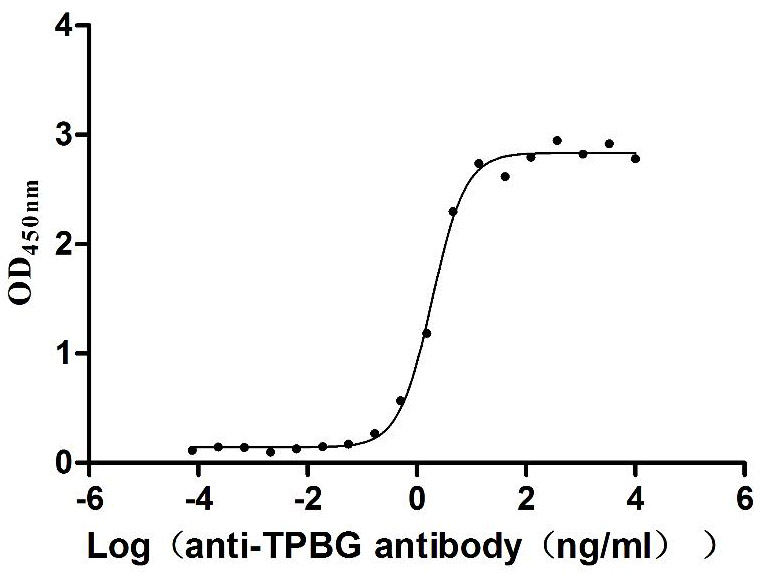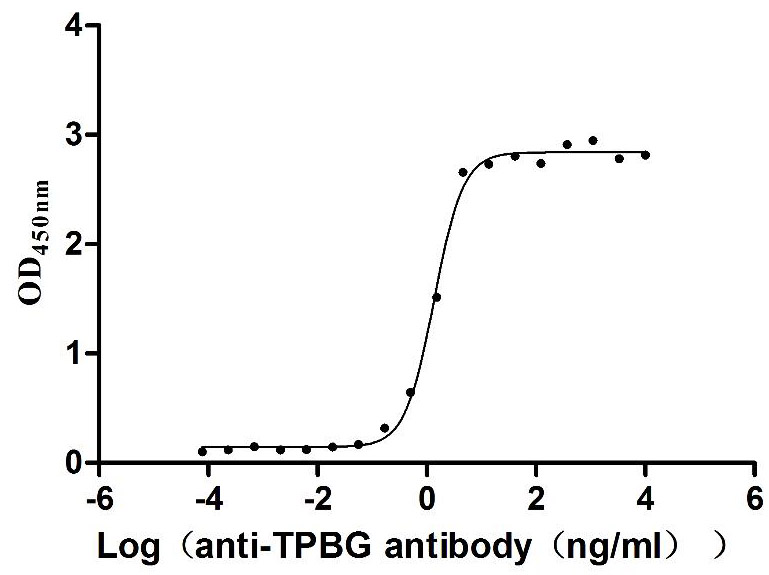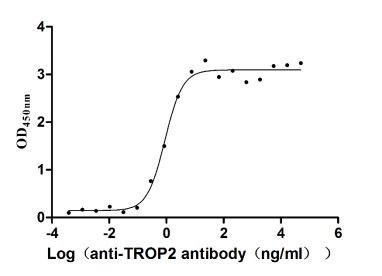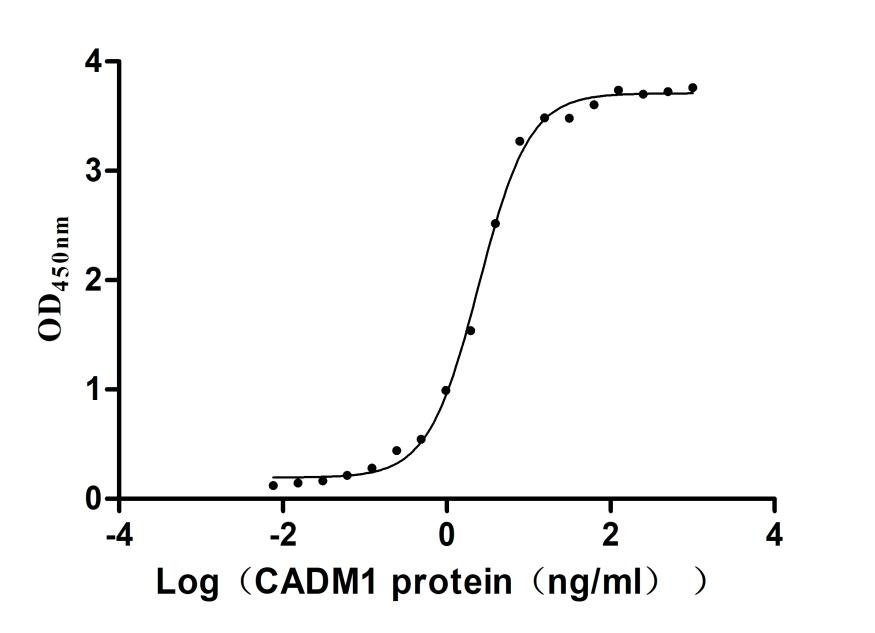Recombinant Mouse Transcription intermediary factor 1-beta (Trim28), partial
In Stock-
中文名稱:Recombinant Mouse Transcription intermediary factor 1-beta (Trim28), partial
-
貨號:CSB-EP717259MO
-
說明書:
-
規格:¥1836
-
圖片:
-
其他:
產品詳情
-
純度:Greater than 85% as determined by SDS-PAGE.
-
生物活性:Not Test
-
基因名:
-
Uniprot No.:
-
種屬:Mus musculus (Mouse)
-
蛋白長度:Partial
-
來源:E.coli
-
分子量:30.6 kDa
-
表達區域:200-400aa
-
氨基酸序列KTRDGERTVYCNVHKHEPLVLFCESCDTLTCRDCQLNAHKDHQYQFLEDAVRNQRKLLASLVKRLGDKHATLQKNTKEVRSSIRQVSDVQKRVQVDVKMAILQIMKELNKRGRVLVNDAQKVTEGQQERLERQHWTMTKIQKHQEHILRFASWALESDNNTALLLSKKLIYFQLHRALKMIVDPVEPHGEMKFQWDLNAWT
Note: The complete sequence may include tag sequence, target protein sequence, linker sequence and extra sequence that is translated with the protein sequence for the purpose(s) of secretion, stability, solubility, etc.
If the exact amino acid sequence of this recombinant protein is critical to your application, please explicitly request the full and complete sequence of this protein before ordering. -
蛋白標簽:C-terminal 6xHis-tagged
-
產品提供形式:Liquid or Lyophilized powder Warning: in_array() expects parameter 2 to be array, null given in /www/web/cusabio_cn/public_html/caches/caches_template/default/content/show_product_protein.php on line 662
Note: We will preferentially ship the format that we have in stock, however, if you have any special requirement for the format, please remark your requirement when placing the order, we will prepare according to your demand. -
緩沖液:If the delivery form is liquid, the default storage buffer is Tris/PBS-based buffer, 5%-50% glycerol. If the delivery form is lyophilized powder, the buffer before lyophilization is Tris/PBS-based buffer, 6% Trehalose, pH 8.0.
-
復溶:We recommend that this vial be briefly centrifuged prior to opening to bring the contents to the bottom. Please reconstitute protein in deionized sterile water to a concentration of 0.1-1.0 mg/mL.We recommend to add 5-50% of glycerol (final concentration) and aliquot for long-term storage at -20℃/-80℃. Our default final concentration of glycerol is 50%. Customers could use it as reference.
-
儲存條件:Store at -20°C/-80°C upon receipt, aliquoting is necessary for mutiple use. Avoid repeated freeze-thaw cycles.
-
保質期:The shelf life is related to many factors, storage state, buffer ingredients, storage temperature and the stability of the protein itself.
Generally, the shelf life of liquid form is 6 months at -20°C/-80°C. The shelf life of lyophilized form is 12 months at -20°C/-80°C. -
貨期:3-7 business days
-
注意事項:Repeated freezing and thawing is not recommended. Store working aliquots at 4℃ for up to one week.
-
Datasheet & COA:Please contact us to get it.
相關產品
靶點詳情
-
功能:Nuclear corepressor for KRAB domain-containing zinc finger proteins (KRAB-ZFPs). Mediates gene silencing by recruiting CHD3, a subunit of the nucleosome remodeling and deacetylation (NuRD) complex, and SETDB1 (which specifically methylates histone H3 at 'Lys-9' (H3K9me)) to the promoter regions of KRAB target genes. Enhances transcriptional repression by coordinating the increase in H3K9me, the decrease in histone H3 'Lys-9 and 'Lys-14' acetylation (H3K9ac and H3K14ac, respectively) and the disposition of HP1 proteins to silence gene expression. Recruitment of SETDB1 induces heterochromatinization. May play a role as a coactivator for CEBPB and NR3C1 in the transcriptional activation of ORM1. Also corepressor for ERBB4. Inhibits E2F1 activity by stimulating E2F1-HDAC1 complex formation and inhibiting E2F1 acetylation. May serve as a partial backup to prevent E2F1-mediated apoptosis in the absence of RB1. Important regulator of CDKN1A/p21(CIP1). Has E3 SUMO-protein ligase activity toward itself via its PHD-type zinc finger. Specifically sumoylates IRF7, thereby inhibiting its transactivation activity. Ubiquitinates p53/TP53 leading to its proteosomal degradation; the function is enhanced by MAGEC2 and MAGEA2, and possibly MAGEA3 and MAGEA6. Mediates the nuclear localization of KOX1, ZNF268 and ZNF300 transcription factors. Probably forms a corepressor complex required for activated KRAS-mediated promoter hypermethylation and transcriptional silencing of tumor suppressor genes (TSGs) or other tumor-related genes in colorectal cancer (CRC) cells. Required to maintain a transcriptionally repressive state of genes in undifferentiated embryonic stem cells (ESCs). In ESCs, in collaboration with SETDB1, is also required for H3K9me3 and silencing of endogenous and introduced retroviruses in a DNA-methylation independent-pathway. Associates at promoter regions of tumor suppressor genes (TSGs) leading to their gene silencing. The SETDB1-TRIM28-ZNF274 complex may play a role in recruiting ATRX to the 3'-exons of zinc-finger coding genes with atypical chromatin signatures to establish or maintain/protect H3K9me3 at these transcriptionally active regions. Acts as a corepressor for ZFP568.
-
基因功能參考文獻:
- Results show that KAP1 maintains H3K9me3 at imprinting control regions and transposable elements and protects them from TETdependent hydroxymethylation. PMID: 29482634
- regulation of epigenetic modifications coordinated by TRIM28 plays a crucial role in reprogramming process. PMID: 28759843
- The interaction of repressor proteins Trim28 and YY1 are involved in the silencing of Moloney murine leukemia virus. PMID: 29407374
- an important role for TRIM28 in cells resisting transition between somatic and pluripotent states, is reported. PMID: 27350605
- TRIM28 safeguards germline-to-soma inheritance of epigenetic features at other genomic regions in an exquisitely stage-dependent manner. PMID: 28115466
- Data suggest that TRIM28 regulates the expression of a subset of lncRNAs. PMID: 27432546
- Zygotic TRIM28 is essential for genomic imprinting. Secondary imprints were hypomethylated in TRIM28 mutants. PMID: 26527006
- Trim28(+/D9) mutant mice exhibit a bi-modal body-weight distribution, with isogenic animals randomly emerging as either normal or obese and few intermediates. PMID: 26824653
- Data suggest that interaction between KAP1 and the KRAB A box of zinc finger protein 809 (ZFP809) is critical in KAP1-dependent control of gene silencing for ZFP809 targets. PMID: 26417948
- We find that NPCs use TRIM28-mediated histone modifications to dynamically regulate transcription and silencing of ERVs, which is in contrast to other somatic cell types using DNA methylation PMID: 25543143
- WTX stabilized chromatin binding by TRIM28 and contributed to transcriptional repression of repetitive sequences by TRIM28 in mouse embryonic stem cells. PMID: 25882849
- KAP-1 may contribute to the repression of Ey and beta-major globin gene transcription through recruitment to the promoters of these two genes, mediated by the interaction of KAP-1 with either Zfp445 or MafK, respectively PMID: 23291531
- the TIF1beta-HP1 system functions as a critical repressive machinery that targets genes not normally activated in the hematopoietic compartment, thereby maintaining the transcriptional signature specific to HSCs. PMID: 24527388
- KAP1 as a previously unappreciated interpreter of cell signaling, which modulates the ability of MyoD to drive myogenesis. PMID: 25737281
- TRIM24, an epigenetic co-regulator of transcription, directly and indirectly represses hepatic lipid accumulation, inflammation, fibrosis and damage in the murine liver. PMID: 25281858
- KAP1 and PRC1 bound cooperatively at the promoters of differentiation-inducible genes and repressed their transcription. PMID: 24687849
- in the absence of TRIM28, we observed increased apoptosis as well as diminished expression of multiple erythroid transcription factors and heme biosynthetic enzymes in immature erythroid cells PMID: 24092935
- Trim28 protects cellular gene expression in early embryos from perturbation by cis-acting activators contained within retroelements. PMID: 23233547
- ATM-Kap-1-mediated chromatin remodeling plays a critical role in premature aging. PMID: 23173799
- Acetylated hsp70 and KAP1-mediated Vps34 SUMOylation is required for autophagosome creation in autophagy. PMID: 23569248
- In mice, hematopoietic-restricted deletion of Kap1 resulted in severe hypoproliferative anemia. Kap1-deleted erythroblasts failed to induce mitophagy-associated genes and retained mitochondria. PMID: 23493425
- Endogenous retrovirus-guided KAP1-induced DNA methylation is recapitulated in embryogenesis. PMID: 23293284
- TRIM28 mediates chromatin modifications at the TCRalpha enhancer and regulates the development of T and natural killer T cells. PMID: 23169648
- These results reveal the so far unsuspected yet important role of KAP1-mediated epigenetic regulation in T-lymphocyte differentiation and activation. PMID: 22872677
- KRAB/KAP1-mediated transcriptional regulation is a central event in metabolic control hormones, drugs, and xenobiotics in the liver and further links disturbances in these processes with hepatic carcinogenesis. PMID: 22684873
- TRIM28 regulates t-cell homeostasis and also interacts with pathways involved in the differentiation of Foxp3+ T cells amd TH17 cells. PMID: 22544392
- The role of KRAB/KAP1-mediated epigenetic regulation in B-cell development and homeostasis. PMID: 22452978
- HP1-dependent regulation of KAP1 influences DNA repair in heterochromatin. PMID: 22205726
- results show that deletion of a single gene, Trim28, from the maternal germ line alone, on an otherwise identical genetic background, results in severe phenotypic and epigenetic variability that leads to embryonic lethality PMID: 22442485
- The results revealed that TRIM28 is differentially required by ZFP568 and other factors during the early stages of mouse embryogenesis. PMID: 22110054
- In embryonic stem cells, ZFP57/KAP1 recognize a methylated hexanucleotide to affect chromatin and DNA methylation of imprinting control regions. PMID: 22055183
- KAP1 and HP1 tether activation-induced cytidine deaminase (AID) to H3K9me3 residues at the donor switch region, thus linking AID to epigenetic modifications during class switch recombination. PMID: 21746811
- Trim28 mutants develop metabolic syndrome and abnormal behavior with incomplete penetrance. PMID: 21092094
- TIF1beta association with HP1 is essential for post-gastrulation development, but not for Sertoli cell functions during spermatogenesis. PMID: 21163256
- TIF1beta provides a phosphorylation-dependent, bidirectional platform for specific transcriptional factors and chromatin remodeling enzymes that regulate the cell differentiation process and the pluripotency of stem cells. PMID: 20508149
- results establish that KAP1 controls endogenous retroelements during early embryonic development PMID: 20075919
- Germ cell expression of the transcriptional co-repressor TIF1beta is required for the maintenance of spermatogenesis. PMID: 11973266
- Data provide evidence for nuclear compartmentalization of transcriptional intermediary factor 1 beta (TIF1beta) that is regulated during cell differentiation through a mechanism that requires heterochromatin protein 1 interaction. PMID: 12154074
- TIF1beta directly binds to the negative regulatory domain of c-Myb and negatively regulates the c-Myb-dependent trans-activation PMID: 14761981
- Pax3 represses transcription through a novel mechanism involving competition between corepressor KAP1 and the heterochromatin-binding protein HP1gamma PMID: 16945326
- Data show that TRIM28 mediates primer binding site-targeted silencing of murine leukemia virus in embryonic cells. PMID: 17923087
- reduction of KAP1 expression resulted in the marked accumulation of STAT3 phosphorylated on Ser727 in the nucleus. Results indicate that KAP1 may serve as a transcriptional regulator of the IL-6/STAT3 signaling pathway PMID: 18037959
- TRIM28 interaction with HP1 is absolutely required for the primer binding site -dependent restriction of murine leukemia virus in the F9 EC cell line. PMID: 18287239
- role of TRIM28 in retroviral restriction PMID: 18713861
- KAP1-mediated epigenetic repression in the forebrain modulates behavioral vulnerability to stress. PMID: 19081377
- KRAB-zinc finger proteins and KAP1 relocalise to novel nucleoplasmic foci that are termed KRAB- and KAP1-associated (KAKA) foci. PMID: 19258395
- Study suggests that KAP-1 is a critical heterochromatic factor that undergoes specific modifications to promote DSB repair and mitotic progression in a manner that allows localized and transient chromatin relaxation. PMID: 19442252
顯示更多
收起更多
-
亞細胞定位:Nucleus.
-
蛋白家族:TRIM/RBCC family
-
數據庫鏈接:
Most popular with customers
-
Recombinant Human Programmed cell death protein 1 (PDCD1), partial (Active)
Express system: Mammalian cell
Species: Homo sapiens (Human)
-
Recombinant Human Heat-stable enterotoxin receptor (GUCY2C), partial (Active)
Express system: Mammalian cell
Species: Homo sapiens (Human)
-
Recombinant Human IGF-like family receptor 1 (IGFLR1), partial (Active)
Express system: Mammalian cell
Species: Homo sapiens (Human)
-
Recombinant Human Interleukin-17A (IL17A) (T26A) (Active)
Express system: Baculovirus
Species: Homo sapiens (Human)
-
Recombinant Macaca fascicularis Trophoblast glycoprotein (TPBG), partial (Active)
Express system: Mammalian cell
Species: Macaca fascicularis (Crab-eating macaque) (Cynomolgus monkey)
-
Recombinant Human Trophoblast glycoprotein (TPBG), partial (Active)
Express system: Mammalian cell
Species: Homo sapiens (Human)
-
Recombinant Human Tumor-associated calcium signal transducer 2 (TACSTD2), partial (Active)
Express system: Mammalian cell
Species: Homo sapiens (Human)
-
Recombinant Human Cytotoxic and regulatory T-cell molecule (CRTAM), partial (Active)
Express system: Mammalian cell
Species: Homo sapiens (Human)




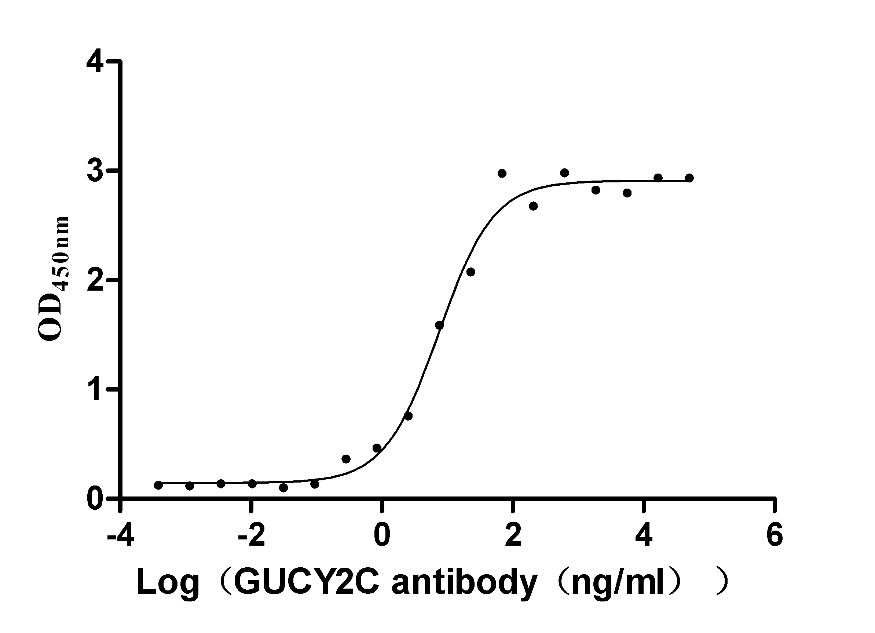
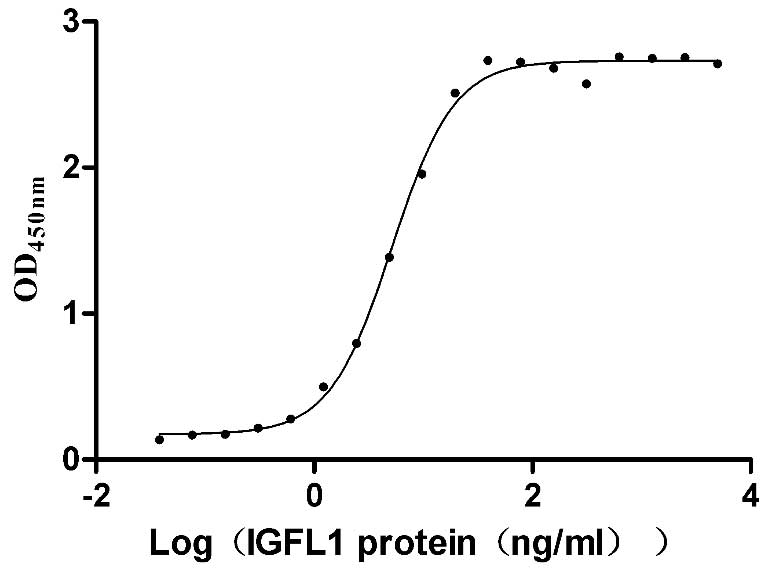
-AC1.jpg)
